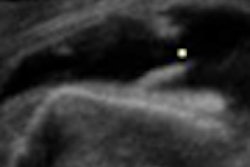Successful vascular ultrasound quality assurance requires consistent use of protocols and interpretation schemes, as well as continuously examining a vascular lab's performance using statistical measures, according to Dr. Laurence Needleman, an associate professor of radiology at Thomas Jefferson University (TJU) in Philadelphia.
Quality includes internal aspects, such as the quality of studies, consistency of performance and interpretation, and qualification of personnel. External aspects of quality include validation of results, accreditation of the facility, and certification of personnel, Needleman said.
"Unless you have some kind of external validation, it's not the same as internal validation," he said.
He spoke during a talk at the annual Leading Edge in Diagnostic Ultrasound meeting, held earlier this year in Atlantic City, NJ.
Protocols are very important, as they define the method of scanning vessels or organs, what to document in a normal study, how to evaluate an abnormality, and how to document abnormalities, Needleman said.
"They always need to be tweaked, and this is something we need to think about in an ongoing manner," he said.
Interpretation schemes should be criteria that are based on accepted evidence, that are clinically relevant, and that are validated by literature or laboratory experience, Needleman said. These criteria can change over time.
"[For example,] the way we measure carotids on angiograms has changed, there's [North American Symptomatic Carotid Endarterectomy Trial (NASCET)] criteria," he said. "If your standards are still 20-40%, 40-60%, 60-80%, and 80-100% [stenosis], that may not be relevant to your clinician anymore."
Every interpreter in the laboratory should use the same grades and the same criteria, Needleman said.
"You can't have a patient have a stenosis [diagnosed] by Dr. Jones, and no stenosis [diagnosed] by Dr. Smith with the same study; it just means one guy read it on Monday and a different guy read it on Tuesday," he said. "How inappropriate is that?"
Any exceptions to the criteria should be explained in the report. If nothing is stated, the assumption is that the quality is OK, he said.
Needleman suggests holding regular in-service/quality meetings, which can serve as a dedicated forum for reviewing the operations of the laboratory. These meetings can review current conditions and future needs and monitor the consistency of performing and interpreting studies, he said.
To determine how well the laboratory is doing, the best approach is to follow up on study findings to confirm that they are real, he said. This follow-up produces a measure of accuracy; correlative studies include gold standards (often angiography), other imaging tests, and surgical/pathological findings, Needleman said.
From this follow-up, sites can determine their sensitivity (how often they call the disease when it is actually present), their specificity (how often they call normal when it's actually normal), their positive predictive value (how often they correctly call the disease compared to all of the times they call disease), and their negative predictive value (how often they correctly diagnose normal compared to all of the times they call normal), Needleman said.
Sensitivity is calculated by dividing true positive findings by the number of all positive patients, while specificity is calculated by dividing true negative findings by the number of all normal patients. Positive predictive value is determined by dividing true positive results by all positive tests, while negative predictive value is calculated by dividing true negative findings by the number of all negative tests, Needleman said.
Examining all of these criteria can determine if there's an issue the laboratory needs to investigate, he said.
"All of them tell slightly different pieces of information," according to Needleman.
Grids also can be created to review findings for different degrees of stenosis, determining the number of undercalls versus overcalls, Needleman said.
By Erik L. Ridley
AuntMinnie.com staff writer
August 4, 2008
Related Reading
Ultrasound quality strongly affects ovarian cancer management, January 21, 2008
Copyright © 2008 AuntMinnie.com




















